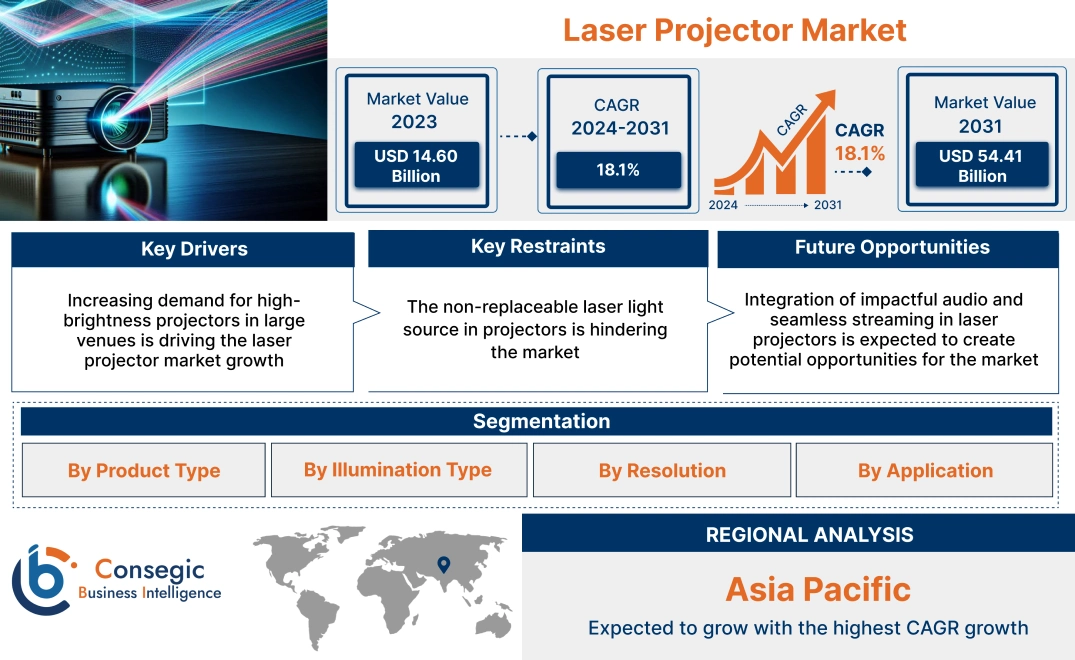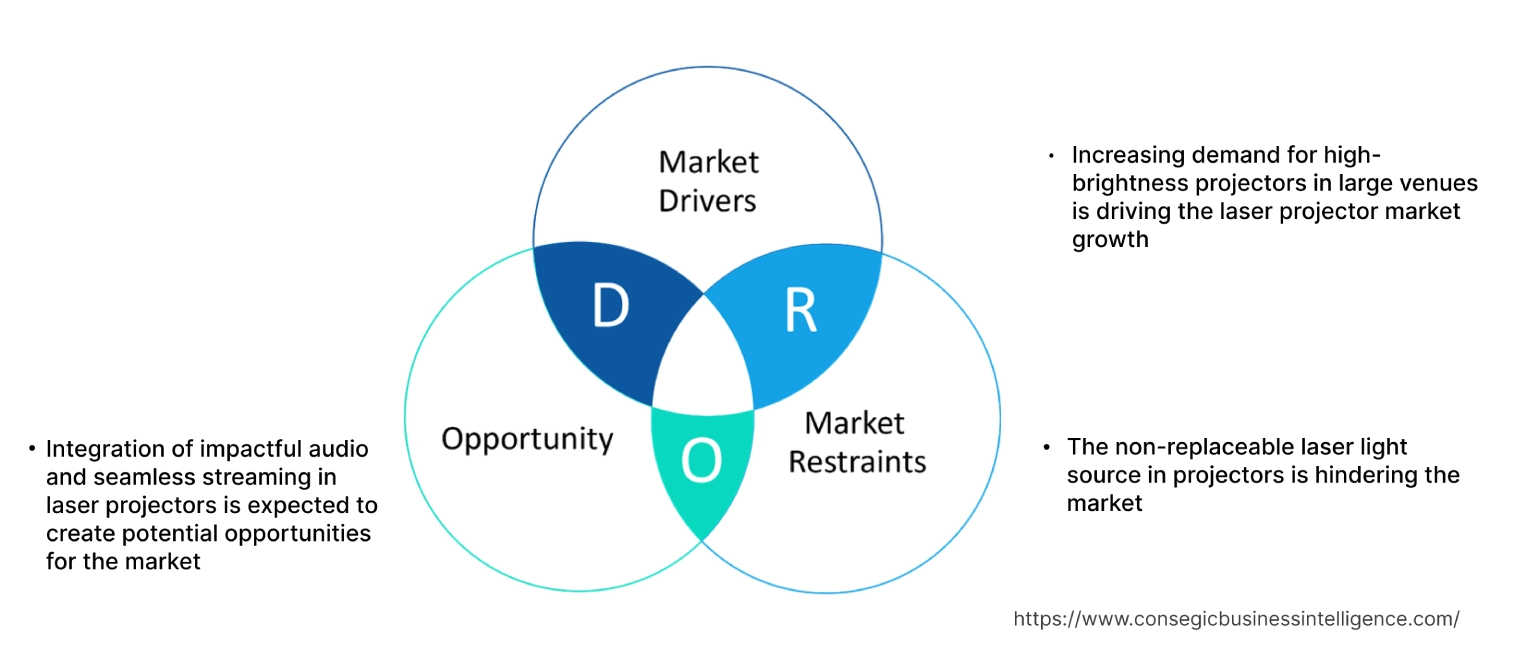Laser Projector Market Scope & Overview:
A laser projector is a device that utilizes laser light to project images onto a screen or any other surface. Unlike traditional projectors that rely on lamps, these projectors employ laser light sources to generate brighter, more vibrant, and long-lasting images.
Additionally, the technology offers several advantages, including improved color accuracy, higher contrast ratios, and a significantly longer lifespan compared to lamp-based projectors. Moreover, such projectors are widely used in various applications, including home theaters, business presentations, and large-scale installations, due to their superior image quality and reliability.
Laser Projector Market Size:
Laser Projector Market size is estimated to reach over USD 54.41 Billion by 2031 from a value of USD 14.60 Billion in 2023 and is projected to grow by USD 17.03 Billion in 2024, growing at a CAGR of 18.1% from 2024 to 2031.
Laser Projector MarketDynamics - (DRO) :
Key Drivers:
Increasing demand for high-brightness projectors in large venues is driving the laser projector market growth
The projectors offer higher brightness and contrast ratios compared to traditional lamp-based projectors, resulting in sharper, detailed images with vibrant colors that withstand ambient light better, ensuring a captivating viewing experience even in well-lit environments. Additionally, laser light sources have a much longer lifespan than traditional lamps, often exceeding 20,000 hours, hence reducing maintenance costs and downtime.
Moreover, the projectors have faster response times compared to lamp-based projectors, resulting in reduced motion blur, important for displaying fast-paced content including sports or action movies. Furthermore, these projectors achieve a wider color gamut, reproducing a broader range of colors with greater accuracy.
- For instance, in August 2024, ViewSonic Corp. introduced a new line of high-brightness projectors designed for business use. The projectors are ideal for large venues including auditoriums, museums, and reception areas, delivering exceptional visual experiences with brightness levels reaching up to 8,500 ANSI Lumens.
- In addition, the new lineup includes six advanced models utilizing DLP technology, providing a comprehensive solution for professional AV partners across various sectors, including business, education, and commercial spaces.
Therefore, the surging projector demand for high brightness in large venues is driving the market.
Key Restraints :
The non-replaceable laser light source in projectors is hindering the market
The non-replaceable laser light source necessitates complete projector replacement after approximately 20,000 hours of use, significantly increasing the total cost of ownership compared to lamp-based projectors, which require only periodic lamp replacements.
In addition, the integrated design of the laser light source limits repair and replacement options for individual components, necessitating complete projector replacement. Moreover, the non-replaceable nature of the laser light source limits the potential for future technological advancements and upgrades, further impeding the market.
Thus, the non-replaceable laser light source in projectors is restricting the progression of the global laser projector market.
Future Opportunities :
Integration of impactful audio and seamless streaming in laser projectors is expected to create potential opportunities for the market
The projector equipped with high-quality audio systems is expected to deliver an enhanced viewing experience, increasing audience engagement across various applications including film, gaming, and professional presentations. Additionally, built-in streaming capabilities allow users to access a vast array of content directly from the projector, eliminating the need for additional devices.
Moreover, projectors equipped with integrated high-quality audio systems and streaming capabilities are expected to deliver an enhanced user experience, thus creating laser projector market opportunities. In the home entertainment sector, the devices offer a premium cinematic experience, appealing to consumers seeking high-quality visuals and auditory performance.
Furthermore, for gamers, the combination of large screens, low latency, and immersive audio systems makes these projectors a compelling choice. In addition, in corporate and educational settings, seamless streaming and high-quality audio enhance the impact of presentations, meetings, and educational content, thus predicted to drive laser projector market demand.
- For instance, in October 2024, Epson launched the new EpiqVision Mini EF22 and EF21 models, compact and portable projectors featuring Full HD HDR picture quality up to 150 inches. The projectors offer built-in Dolby audio for immersive sound and Google TV for seamless access to thousands of streaming apps, including Netflix, Disney+, and even live TV5 from apps like YouTube TV.
Hence, the integration of impactful audio and seamless streaming is expected to create potential laser projector market opportunities.
Top Key Players & Market Share Insights:
The market is highly competitive with major players providing casino management solutions to the national and international markets. Key players are adopting several strategies in research and development (R&D), product innovation, and end-user launches to hold a strong position in the market. Key players in the Laser Projector industry include-
- Panasonic Corporation (Japan)
- Sony Corporation (Japan)
- LAP GmbH (Germany)
- NEC Display Solutions (Japan)
- Optoma (Taiwan)
- Ricoh (Japan)
- VAVA (China)
- ViewSonic Corporation (U.S.)
- Xiaomi (China)
- LG Electronics (South Korea)
- BenQ America Corp. (Taiwan)
- Canon Inc. (Japan)
- CASIO COMPUTER CO., LTD. (Japan)
- Christie Digital Systems USA, Inc. (U.S.)
- Dell (U.S.)
- Delta Electronics, Inc. (Taiwan)
- FARO Technologies, Inc. (U.S.)
- Hitachi Digital Media Group (Japan)
Laser Projector Market Segmental Analysis :
By Product Type:
Based on the product type, the market is segmented into laser projector and CAD laser projection system.
Trends in the Product Type:
- Miniaturization of laser technology is enabling the development of portable projectors, ideal for mobile applications is driving the laser projector market trend.
- Continuous advancements in laser technology, such as improved light sources and optical systems, are enabling the development of more powerful and efficient projectors.
The laser projector segment accounted for the largest revenue share in the year 2023.
- These projectors offer significantly higher brightness, better color accuracy, and deeper blacks compared to lamp-based projectors, resulting in remarkable visuals with sharper details and vibrant colors.
- Additionally, these projectors are more reliable and less prone to failures compared to lamp-based projectors as they have fewer moving parts and are less susceptible to heat-related issues.
- Moreover, these projectors are suitable for a wide range of applications, including home theatres, corporate presentations, education, and large-scale events.
- For instance, in Nov 2024, Sharp Electronics Corporation launched Sharp XP-X171Q featuring 4K Ultra High-Definition resolution with high brightness, designed for areas like corporate conference rooms, higher education classrooms, museums, and more. The X171Q delivers visuals with 9.2 million pixels and 16,500 lumens of brightness. In addition, the innovative red assist laser technology enhances color accuracy, particularly in the red spectrum, while the blue laser ensures exceptional brightness.
- Thus, the aforementioned benefits including superior picture quality, longer lifespan, and versatile applications are driving the laser projector market share.
The CAD laser projection systems are expected to witness significant CAGR during the forecast period.
- CAD projectors offer exceptional image quality, high resolution, and precise color accuracy, enabling engineers, architects, and designers to visualize designs with supreme detail.
- Moreover, CAD projectors allow for large-scale projections, eliminating the need for multiple monitors or small-screen displays.
- Additionally, CAD projectors provide a powerful solution for visualizing complex 3D models and simulations.
- Furthermore, CAD projectors are increasingly used in educational institutions and training centers to provide immersive and interactive learning experiences.
- Therefore, the rising adoption of CAD projectors in education and training and the growing need for advanced visualization tools are anticipated to boost the CAD laser projector market trends during the forecast period.
By Illumination Type:
Based on the illumination type, the market is segmented into laser phosphor, hybrid, RGB laser, laser diode, and others.
Trends in the Illumination Type:
- As the technology matures and costs decrease, RGB projectors are expected to gain significant market share, especially in premium segments.
- The trend towards hybrid projectors is projected to be an ideal choice for users seeking a balance between performance and cost.
The laser phosphor segment accounted for the largest revenue share of 42.14% in the year 2023.
- Laser phosphor projectors use a single blue laser diode and a phosphor wheel, which is a simpler and more cost-effective design compared to RGB projectors.
- The technology offers a longer lifespan and requires less maintenance than traditional lamp-based projectors, thus leading to lower operational costs over time.
- Moreover, the simpler design of laser phosphor projectors allows for a more compact and lightweight form factor compared to RGB projectors, making them easier to transport and install.
- For instance, in October 2023, Sharp introduced two new projectors, NC603L and NC1503L, equipped with the latest RB Laser Phosphor technology. The innovative technology eliminates speckle, ensuring a high-quality viewing experience, and is designed without external chillers, offering cost-saving benefits. Furthermore, the compact size allows for ceiling mount installation, providing cinema owners with greater versatility.
- Thus, the combination of lower production costs, reduced maintenance requirements, and compact form factors is significantly contributing to the increasing market share of laser phosphor projectors.
The RGB laser is expected to witness significant CAGR during the forecast period.
- RGB projector achieves a wider color gamut, closer to the Rec. 2020 standard, resulting in more vibrant and accurate colors.
- Additionally, the projectors achieve higher brightness levels, suitable for large-scale installations and bright environments.
- Moreover, this projector has faster response times, leading to smoother motion and reduced motion blur.
- Furthermore, RGB projectors have a longer lifespan than traditional laser phosphor projectors, reducing maintenance costs.
- For instance, in September 2023, Optoma introduced ML1080 and ML1080ST, portable projectors featuring RGB triple laser technology to offer a wide BT2020 color gamut, typically found in larger, more expensive home cinema projectors. With Full HD 1080p resolution, 1200 lumens brightness, and a compact design, the ML1080 and ML1080ST are ideal for home entertainment, gaming, and professional presentations.
- Overall, the combination of superior performance, increasing affordability, and growing need is expected to drive significant laser projector market expansion in the RGB projector segment during the forecast period.
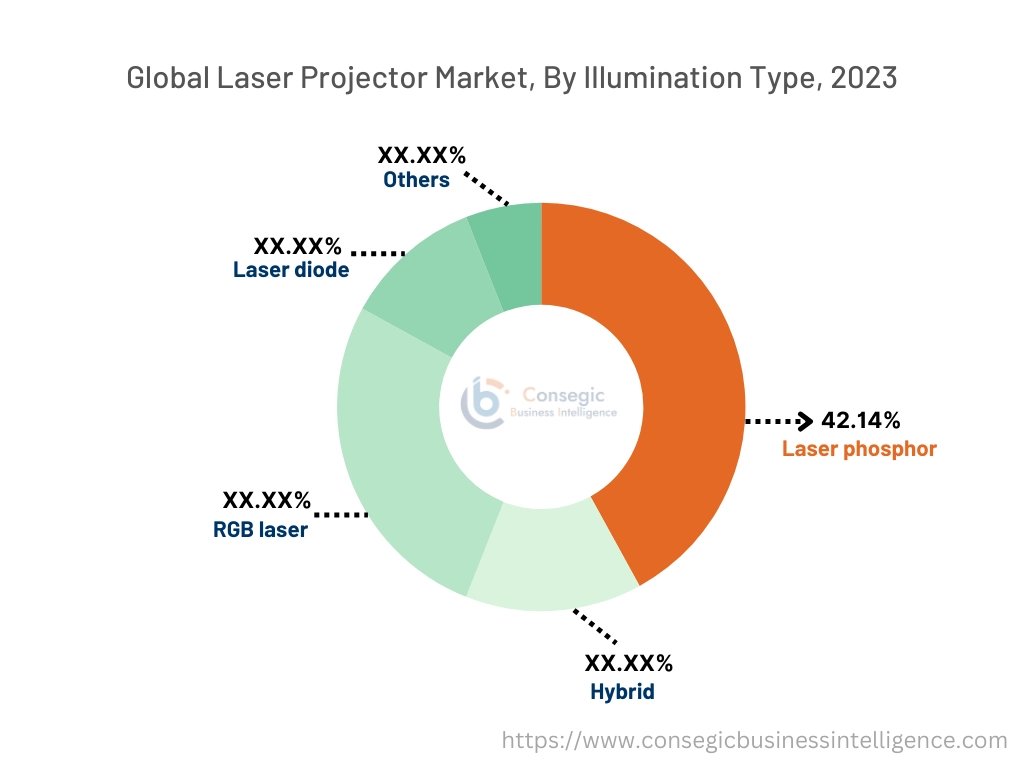
By Resolution:
Based on the resolution, the market is segmented into XGA (1024 x 768 Pixels), WXGA (1280 x 800 Pixels), HD (1920 x 1080 Pixels), 4K (4096 x 2160 Pixels) and others.
Trends in the Resolution:
- The trend towards the proliferation of 4K content, including movies, TV shows, and video games, drives demand for 4K projectors.
- Improved laser light sources enable higher brightness and contrast ratios, to achieve better image quality at higher resolutions.
The 4K segment accounted for the largest revenue share in the year 2023 and is expected to witness the fastest CAGR.
- 4K resolution offers significantly higher detail and clarity, ideal for home theatres, gaming, and professional applications.
- The rise of streaming services and 4K content production are fueling the need for 4K projectors.
- Additionally, improvements in laser technology, including increased brightness and contrast ratios, offered by 4K visuals are also driving the market.
- For instance, in May 2024, BenQ launched the latest 4K home theatre projector, the W5800 with CinematicColor technology and HDR-Pro, delivering accurate colors and enhanced visual details. Additionally, W5800 offers a truly cinematic experience and is the only 4K home cinema projector to achieve 100% DCI-P3 color accuracy. Furthermore, with its ability to project images up to 200 inches, it is an ideal choice for home theatre enthusiasts seeking an immersive viewing experience.
- In conclusion, the analysis states that the above-mentioned factors are contributing remarkably to driving the market.
By Application:
Based on the application, the market is segmented into enterprise, public places, cinema, education, retail, medical, industrial and others.
Trends in the application:
- Integration with touch-sensitive screens and interactive software enables collaborative workspaces and engaging presentations.
- High-brightness projector is used for outdoor advertising, digital billboards, and information displays in public spaces.
Enterprise accounted for the largest revenue share in the year 2023.
- These projectors offer superior image quality, brightness, and color accuracy, ideal for corporate presentations, meetings, and conferences.
- Integrating touch-sensitive screens and interactive software creates dynamic workspaces that promote collaboration and deliver captivating presentations.
- The projectors are used to create immersive digital signage and video walls for branding, advertising, and information dissemination.
- For instance, in November 2023, LG ProBeam BU53RG with 4K Ultra HD resolution, delivered exceptionally sharp and bright images. Designed specifically for business enterprises, the LG ProBeam BU53RG is poised to elevate presentations, meetings, and digital signage to new heights, offering a visually stunning experience.
- Thus, the analysis states that the rising adoption of projectors in enhancing presentation capabilities and creating immersive digital signage is driving these projectors in the enterprise segment.
The cinema segment is anticipated to register the fastest CAGR during the forecast period.
- The projectors are rapidly replacing traditional lamp-based projectors due to their superior brightness, color accuracy, and longer lifespan, offering a more immersive viewing experience with higher contrast ratios and wider color gamuts.
- Cinema operators are investing in advanced audio technologies like Dolby Atmos and DTS:X to create immersive sound environments that complement the visual experience.
- Moreover, the implementation of strategic decisions by key players to expand the adoption of laser projectors in cinemas is also propelling market growth.
- For instance, in July 2024, Regal Cinemas partnered with Christie to install over 280 RGB pure projectors across various locations in the United States. The significant upgrade will enable Regal to deliver stunning visuals with superior brightness, color accuracy, and contrast, elevating the cinematic experience for audiences.
- Thus, according to the laser projector market analysis, the rising adoption of projectors in cinemas is anticipated to boost the market during the forecast period.
Laser Projector Market Report Insights :
| Report Attributes | Report Details |
| Study Timeline | 2018-2031 |
| Market Size in 2031 | USD 54.41 Billion |
| CAGR (2024-2031) | 18.1% |
| By Product Type |
|
| By Illumination Type |
|
| By Resolution |
|
| By Application |
|
| By Region |
|
| Key Players |
|
| North America | U.S. Canada Mexico |
| Europe | U.K. Germany France Spain Italy Russia Benelux Rest of Europe |
| APAC | China South Korea Japan India Australia ASEAN Rest of Asia-Pacific |
| Middle East and Africa | GCC Turkey South Africa Rest of MEA |
| LATAM | Brazil Argentina Chile Rest of LATAM |
| Report Coverage |
|
Regional Analysis:
The regions covered are North America, Europe, Asia Pacific, the Middle East and Africa, and Latin America.
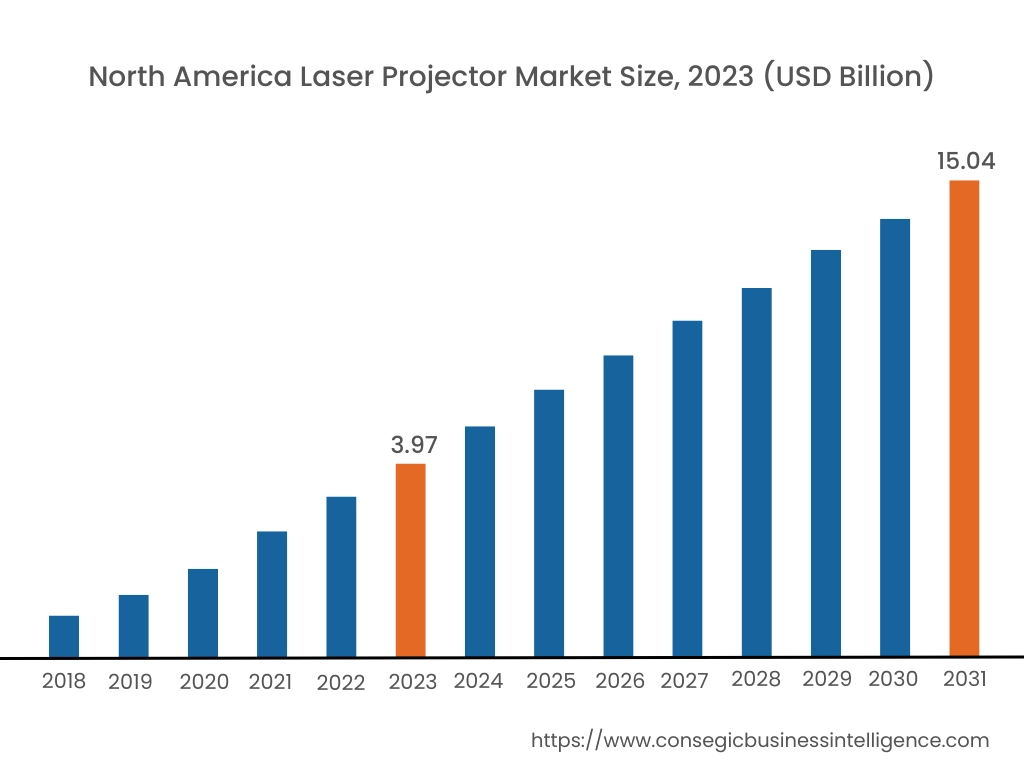
North America is estimated to reach over USD 15.04 Billion by 2031 from a value of USD 3.97 Billion in 2023 and is projected to grow by USD 4.64 Billion in 2024. Out of this, the U.S. accounted for the maximum revenue share of 70.53%. The region boasts a thriving entertainment industry, including Hollywood film production and many cinemas. The projectors offer superior image quality, brightness, and color accuracy, ideal for high-end cinema experiences. Additionally, the presence of key players in the region is also contributing notably to boosting the market.
- For instance, in August 2023, Christie introduced two new RGB projectors, the M 4K15 RGB and M 4K+15 RGB. These projectors offer 15,750 lumens of brightness, UHD 4K and UHD 4K+ resolutions, and a wide color gamut. Additionally, they are designed for applications such as large venues, theatres, and control rooms, offering high performance and long lifespans.
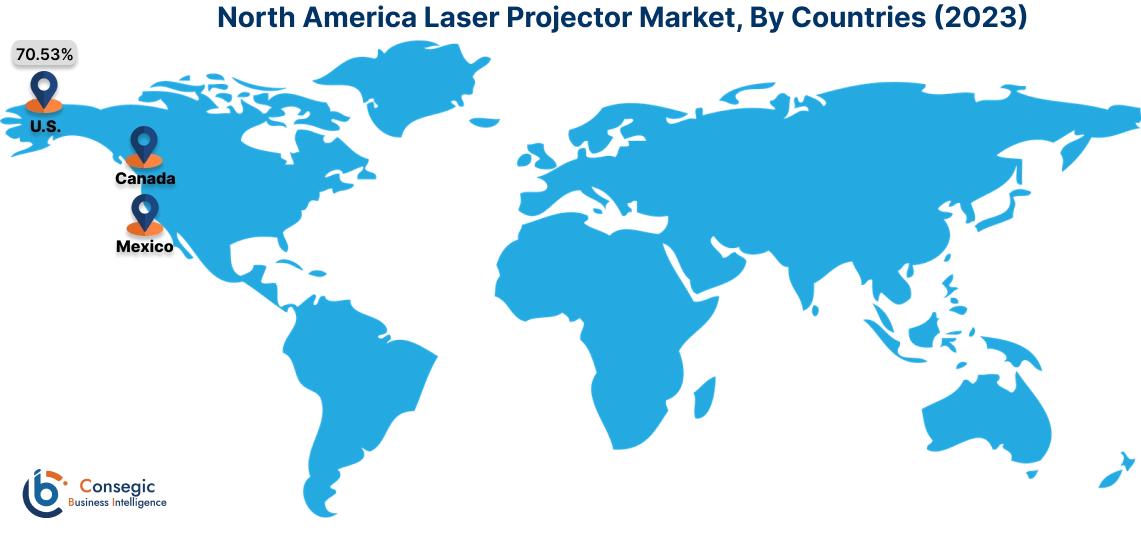
Asia Pacific region was valued at USD 5.89 Billion in 2023. Moreover, it is projected to grow by USD 6.88 Billion in 2024 and reach over USD 22.52 Billion by 2031. According to the laser projector market analysis, the Asia Pacific region leads as the governments in the region are investing heavily in smart city projects, which involve the deployment of advanced technologies for public displays, digital signage, and educational purposes. Moreover, the expansion of infrastructure projects, including transportation hubs and public spaces, is also creating opportunities for the installation of large-format projectors. Furthermore, the presence of key players in the region is also contributing notably to boosting the market.
- For instance, in December 2022, Optoma introduced a new series of eco-friendly and energy-efficient projectors, specifically catering to the needs of educational institutions in India. These projectors offer a sustainable and cost-effective solution for enhancing classroom learning experiences, contributing to a greener future for education.
As per the analysis, Europe represents a mature market for projectors and the key factors driving the laser projector market growth include the increasing demand for high-quality visuals in professional settings like boardrooms and classrooms. Additionally, the rising demand for 4K and 8K resolution content in Europe is also fueling the market. Moreover, Latin America is an emerging market for projectors, with significant potential for growth in the commercial sector, including corporate offices and educational institutions, and is contributing to laser projector market expansion. Furthermore, the analysis states that the Middle East and Africa (MEA) is a diverse region with varying levels of economic development. However, the market is experiencing significant growth in key countries like the UAE, Saudi Arabia, and South Africa. The region's affluent population is driving laser projector market demand for high-end home theater systems and luxury installations. In addition, the growth of the entertainment industry and government investments in infrastructure projects are also contributing to market growth.
Recent Industry Developments :
Partnerships & Collaborations:
- In Sep 2024, Barco partnered with Miraj Cinemas, one of India's largest cinema chains. The three-year deal makes Barco the preferred supplier of visualization solutions for Miraj's expanding network of theatres. Barco will provide its advanced projectors for both new installations and upgrades at existing Miraj locations, starting with sites in Chennai and Wadala, Mumbai. This collaboration aims to elevate the cinematic experience for Miraj patrons by delivering superior image quality and immersive viewing.
- In Apr 2023, Cineplex partnered with Cinionic, to upgrade 800 of its largest screens with cutting-edge projector. The project aims to enhance the cinematic experience for Canadian moviegoers by providing superior picture quality, increased brightness, and vibrant colors. By adopting Cinionic's laser projection technology, Cineplex is positioning itself at the forefront of the cinema laser projector industry in Canada.
Key Questions Answered in the Report
How big is the Laser Projector market? +
The market was valued at USD 14.60 Billion in 2023 and is projected to grow to USD 54.41 Billion by 2031.
Which is the fastest-growing region in the Laser Projector market? +
Asia-Pacific is the region experiencing the most rapid growth in the market.
What specific segmentation details are covered in the Laser Projector report? +
The laser projector report includes specific segmentation details for product type, illumination type, resolution, application, and region.
Who are the major players in the Laser Projector market? +
The key participants in the market are Panasonic Corporation (Japan), Sony Corporation (Japan), LG Electronics (South Korea), BenQ America Corp. (Taiwan), Canon Inc. (Japan), Dell (U.S.), Delta Electronics, Inc. (Taiwan), FARO Technologies, Inc. (U.S.), Hitachi Digital Media Group (Japan), and others.
